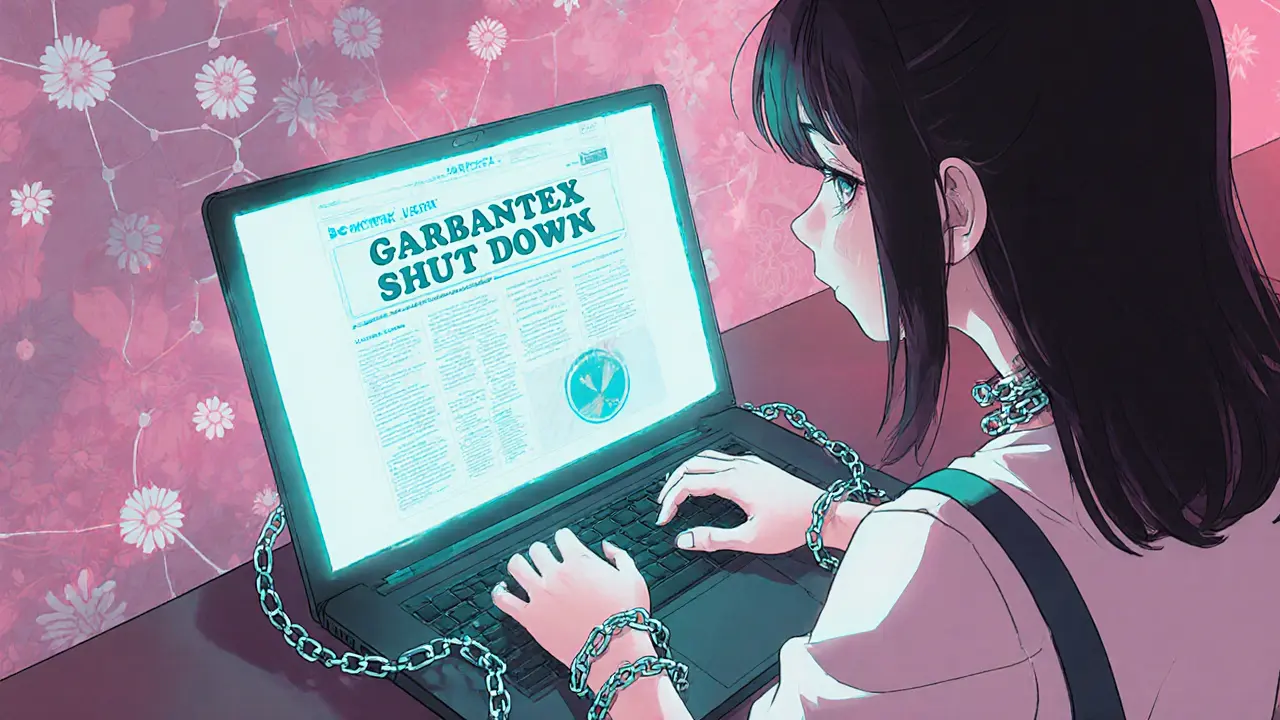Russian Sanctions and Crypto Exchange Access Limitations: How Garantex, Grinex, and A7A5 Got Blocked

Sanction Risk Checker for Stablecoins
Check Stablecoin Safety
Enter a stablecoin name to assess its risk of being frozen by U.S. sanctions based on blockchain analytics and regulatory history.
When Russia was hit with sweeping financial sanctions in 2022, many Russians turned to cryptocurrency to protect their money. Banks were cut off from SWIFT. International payments froze. People needed a way to move value - and crypto seemed like the answer. But what started as a survival tactic became a target. By August 2025, the U.S. government had taken down not just one, but an entire ecosystem of crypto exchanges built to evade sanctions. The story isn’t just about rules being broken. It’s about how the world’s most powerful financial enforcers learned to track digital money - and shut it down, one wallet at a time.
Garantex: The Exchange That Started It All
Garantex wasn’t just another crypto exchange. It was the largest peer-to-peer trading platform in Russia, handling over $10 billion in transactions since its launch in 2018. Unlike centralized exchanges like Binance or Coinbase, Garantex let users trade directly with each other, often using rubles or USDT. That made it perfect for Russians who couldn’t use traditional banks. But it also made it perfect for criminals.
By 2022, the U.S. Treasury’s Office of Foreign Assets Control (OFAC) had enough. On April 5, 2022, Garantex was officially sanctioned under Executive Order 14024. The reason? Operating in Russia’s financial services sector. But that was just the beginning. The real turning point came in March 2025, when the U.S. Secret Service led a global operation that seized Garantex’s domains, confiscated servers, and froze over $26 million in cryptocurrency. One of its co-founders, Aleksej Besciokov, was arrested while on vacation in India.
Garantex didn’t vanish quietly. Its employees had already started building a replacement.
Grinex: The Ghost Exchange
Within days of Garantex’s shutdown, a new platform appeared: Grinex. Its website openly admitted it was created "in response to sanctions and asset freezes that affected Garantex." It wasn’t just a rebrand. It was a full rebuild - same team, same infrastructure, same customers.
Grinex promised one thing: access to frozen funds. To do that, it introduced A7A5, a new stablecoin pegged to the Russian ruble. Unlike USDT, which could be frozen by Tether’s central team, A7A5 was designed to be harder to track. It ran on both TRON and Ethereum, making it harder for regulators to cut off access. By August 2025, Grinex had already processed billions in transactions. It wasn’t just surviving - it was thriving.
Then, on August 14, 2025, OFAC struck again. This time, they sanctioned Grinex under Executive Order 13694, which targets cyber-enabled financial crimes. The designation didn’t stop at the exchange. It included three Garantex executives - Sergey Mendelev, Aleksandr Mira Serda, and Pavel Karavatsky - and six companies linked to the operation across Russia and Kyrgyzstan. The U.S. State Department also offered up to $6 million in rewards for information leading to their arrest.
The A7 Network: A $8 Billion Underground System
Grinex wasn’t alone. It was part of a larger network known as the "A7" ecosystem. This included companies like A7, A71, A7 Agent, InDeFi Bank, and Exved. According to blockchain analytics firm Elliptic, these entities had received over $8 billion in cryptocurrency since early 2024. That’s not a typo. Eight billion dollars - all flowing through wallets designed to avoid detection.
The A7A5 token was the glue holding it together. It let Russian users convert frozen USDT into something that couldn’t be easily frozen. It also let them trade with each other without touching traditional banking systems. But Elliptic didn’t just watch - they acted. In August 2025, they updated their monitoring tools to flag A7A5 transactions on both TRON and Ethereum. That meant any exchange using Elliptic’s software could now block those transfers.
And then, on August 14 - the same day Grinex was sanctioned - something strange happened. A7A5 wallets showed unusual activity. Some believe it was a security breach. Others think it was a last-minute infrastructure shift to avoid detection. Either way, the timing wasn’t a coincidence. The system was under pressure.

Why USDT Failed and A7A5 Rose
Why did Russians stop using USDT? Because it’s not as decentralized as people think. Tether, the company behind USDT, can freeze wallets. When Garantex was shut down in March 2025, users found their USDT locked. No appeal. No recourse. That’s when the search for a truly independent stablecoin began.
A7A5 was built to solve that. Issued by a Kyrgyzstani firm, it had no central authority with the power to freeze funds. It used smart contracts on public blockchains. No middleman. No single point of failure. For users, it was freedom. For regulators, it was a nightmare.
But freedom has a cost. The same anonymity that made A7A5 appealing also made it a magnet for ransomware gangs, fraudsters, and money launderers. Elliptic’s analysis showed that many of the A7 network’s transactions were linked to known cybercriminal wallets. That’s what gave OFAC the legal grounds to act.
What This Means for Russian Crypto Users
If you’re a Russian citizen trying to access crypto now, the landscape has changed drastically. The big exchanges are gone. The replacements are sanctioned. Even the stablecoins you trusted are being tracked.
Some users have turned to decentralized exchanges (DEXs) like Uniswap or PancakeSwap, but those require technical skill. Others use peer-to-peer platforms like LocalBitcoins or Paxful, but those are increasingly monitored. Even buying crypto with cash in person carries risk - law enforcement now has tools to trace the flow of funds back to known sanctioned wallets.
The message from the U.S. is clear: if you’re helping Russia bypass sanctions, you’re not just breaking rules - you’re a target. And the tools to catch you are better than ever.

How Enforcement Is Changing
This isn’t just about freezing accounts anymore. It’s about dismantling entire networks. The U.S. didn’t just sanction Garantex. They went after its executives, its successor, its token, its supporting companies, and the blockchain analytics that made it all possible.
The strategy is multi-layered:
- Law enforcement: Arrests abroad, server seizures, domain takedowns
- Financial sanctions: OFAC designations that block all U.S. transactions
- Private sector cooperation: Elliptic and other analytics firms sharing data with agencies
- Financial incentives: $6 million in rewards to turn insiders
This is the new normal. No more waiting for years to act. When a platform shows signs of sanctions evasion, the response is fast, coordinated, and brutal.
The Bigger Picture
These actions are part of a global shift. Countries are no longer just talking about crypto regulation - they’re weaponizing it. The U.S. is using sanctions as a digital battlefield. Russia, in turn, is building its own crypto infrastructure to survive.
But the cat-and-mouse game isn’t over. New stablecoins are already in development. New exchanges are being coded. New wallets are being created. The A7 network may be down, but the need for it isn’t.
For now, Russian users have fewer options. For regulators, the tools are sharper. And for everyone else watching - the message is the same: crypto isn’t anonymous. It’s traceable. And if you’re helping a sanctioned regime, you’re not just taking a risk. You’re on a list.
Are Russian crypto exchanges still operational?
No major Russian crypto exchanges like Garantex or Grinex are openly operating under their original names. Both have been sanctioned by the U.S. Treasury, and their domains, servers, and executives have been targeted. Any platform claiming to be a successor is likely operating illegally and is at high risk of being blocked or seized.
Can Russians still use USDT after the sanctions?
Technically yes, but it’s risky. Tether can freeze USDT wallets linked to sanctioned entities. After Garantex was shut down, many users found their USDT locked. While USDT is still used in some peer-to-peer trades, most Russians now avoid it for large transfers because of its centralized control. Alternatives like A7A5 were created specifically to avoid this problem.
What is A7A5 and why was it created?
A7A5 is a ruble-backed stablecoin created by a Kyrgyzstani company to replace USDT for Russian users. It was designed to be decentralized, meaning no single entity can freeze wallets. It runs on TRON and Ethereum and was used by Grinex to help users regain access to frozen funds after Garantex was shut down. Over $8 billion has flowed through A7-linked wallets since early 2024.
Can blockchain analytics firms like Elliptic really track crypto transactions?
Yes. Firms like Elliptic use advanced tools to trace wallet connections, even across multiple blockchains. They can identify patterns, link wallets to known criminal entities, and flag suspicious activity. In the case of Garantex, Elliptic helped the U.S. Secret Service trace and freeze $26 million in USDT. Their ability to monitor A7A5 shows how quickly these tools adapt to new threats.
Is it still possible to access crypto in Russia today?
It’s harder than ever. Major exchanges are blocked. Peer-to-peer trading is risky and monitored. Decentralized exchanges require technical knowledge. While some Russians still access crypto through VPNs or offshore platforms, doing so carries legal and financial risk. The U.S. and allied nations are actively sharing intelligence to track these flows, making anonymity nearly impossible.
What happens if someone uses a sanctioned crypto exchange?
If you’re outside the U.S. and use a sanctioned exchange like Grinex, you won’t be arrested immediately - but your transactions may be frozen. If you’re a U.S. citizen or use a U.S.-based service, you could face fines or criminal charges. Even non-U.S. users risk being cut off from global banking systems if their crypto activity is flagged by international monitoring tools.
Mike Calwell
lol so crypto ain't anonymous after all. who knew?
Jay Davies
Actually, crypto has always been traceable-it's just that most people didn't understand how blockchain analytics work. The real story here is the institutionalization of financial enforcement, not the failure of decentralization. Elliptic's role is particularly noteworthy: they're essentially acting as a private intelligence arm for OFAC. This isn't regulation-it's surveillance capitalism with legal backing.
Barbara Kiss
There's something deeply poetic about this whole saga. People turned to crypto not for profit, but for survival-only to find that the very tool meant to liberate them became another cage, forged not by tyrants but by algorithms and sanctions. The irony is thick enough to choke on. We built decentralized systems to escape centralized control… only to have the controllers adapt, co-opt, and weaponize the very transparency we thought was our shield.
What’s truly terrifying isn’t that A7A5 got shut down. It’s that the next version is already being coded in a basement somewhere, by someone who just wants to pay their rent without being monitored. The cat-and-mouse game isn’t about crime-it’s about dignity. And dignity doesn’t need a blockchain. It just needs space.
Nataly Soares da Mota
Let’s be real: the A7 ecosystem wasn’t a ‘sanctions evasion network’-it was a financial insurgency. You can’t just freeze $8 billion in value without triggering a systemic response. The U.S. didn’t just sanction an exchange; they declared war on financial sovereignty in the Global South. And they used blockchain analytics-not as a tool for compliance, but as a scalpel for economic domination.
The fact that they offered $6 million for intel? That’s not justice. That’s bounty hunting with a Treasury seal. And the use of Elliptic? That’s the privatization of law enforcement dressed up as ‘public-private partnership.’ Welcome to the new Cold War: crypto as battlefield, wallets as weapons, and ordinary people caught in the crossfire.